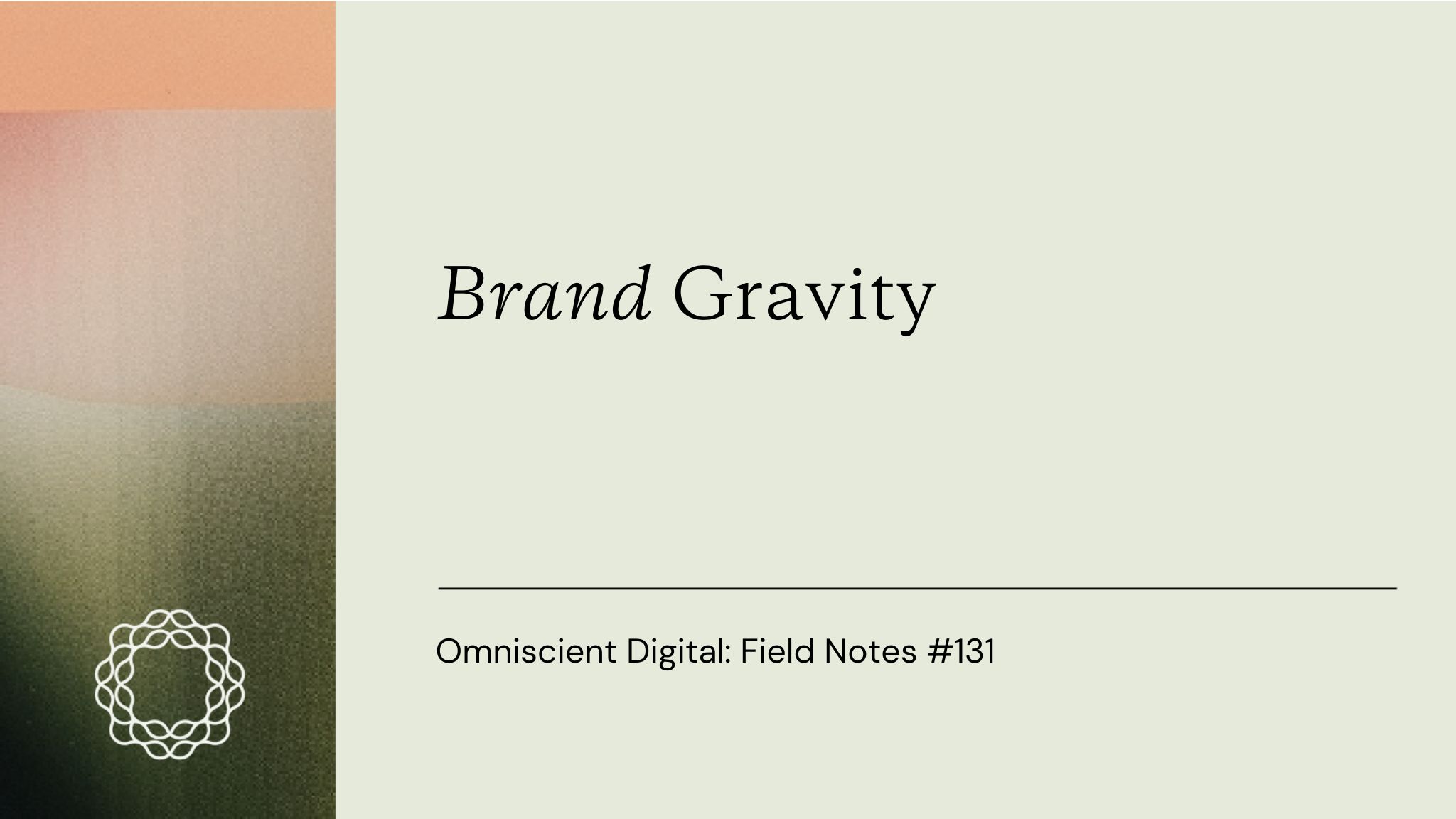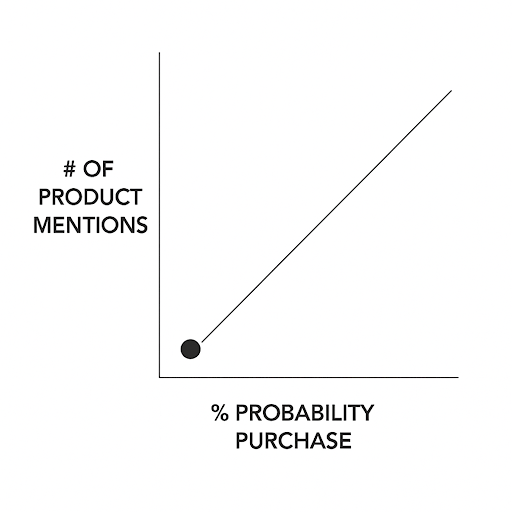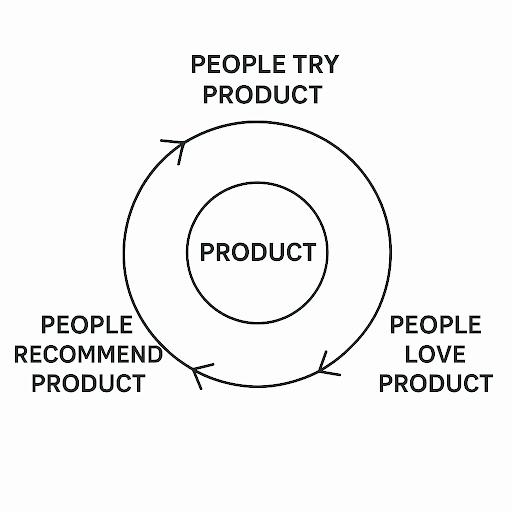
When your brand appears in relation to a query or categorical phrase – best CRM, construction ERP, Paleo cereal, B2B personalization, pizza in Williamsburg —it picks up mass.
Mention by mention, through various touchpoints – private Slack channels, Reddit threads, Product Hunt roundups, and of course, listicles, review sites, and blog posts – you pick up a sort of categorical ubiquity or top of mind awareness.
This relates to LLM optimization and SEO, but it also resembles a natural path to product discovery.
Imagine I’m on the hunt for a new book recommendation:

If one person were to mention The Power Broker, it would pique my curiosity but perhaps not tip me to the point where I run to the book store to purchase it.

However, if every single person at my proverbial cocktail party raves about The Power Broker, I’m sort of helpless. I’m going to check out that damn book.

It’s obviously not linear and clean like this, as some sources and mentions are more influential than others (i.e. hearing a book recommendations from the NY Times versus a random person as a party you just met), but a good rule of thumb is that more mentions equals more awareness which translates to product signups and conversions.

This is the basis for what we’ve called Surround Sound SEO, where you attempt not only to rank your page, but to monopolize the rest of the results with favorably mentions. That way, when someone searches “best CRM,” you’re the obvious choice.
The cumulative exposure gathers enough pull that the next in-market buyer is operating under a conscious and unconscious assumption that your brand is a logical choice. They orbit the brand that shows up everywhere, and that brand, at the very least, enters the consideration set.
That magnetic accumulation is brand gravity.
It follows a cumulative logic, as well, given product quality and experience.
For example, I eventually did read The Power Broker and I haven’t shut up about it since. My business partner David even bought me a mug that says “I finished The Power Broker,” and I often drink from it on virtual calls.
I know that I’ve explicitly convinced three people to buy and read the book (and potentially more, given I’ve reviewed it on Goodreads and in my personal newsletter). Flywheels, baby!

Brand gravity is logically important, and it always has been, but it’s also likely the most reliable route to organic visibility, because large-language models no longer send traffic the way ten blue links once did. They synthesize a variety of sources and training data (plus customization based on memory, context documents, and multi-chain prompts) into a single response.
To earn a place inside that response, you must seed the consensus itself.
It’s a bit hand wavy to say “build your brand,” or “go get brand mentions,” though isn’t it? I’ll elucidate here how we think about it.
Brand Mentions are the New Backlinks
Backlinks, to an arguable degree of impact, tell Google whose page to trust; brand mentions now, to a similarly arguable degree, tell LLMs which brand to recommend.
Two architectural facts explain why:
- Static training vs. RAG. Some tools eat a frozen snapshot of the web; others fetch fresh pages in real time. Lots written about how (and lots more still to uncover). Either way, they pick winners by frequency and context, not just PageRank. A good rule of thumb, beyond short term gamification and hacks, is this: If people don’t recommend you, no model will either .
- Token economics. A model’s job is to predict the next token. If “HubSpot” reliably follows best CRM, the prediction becomes safer to emit, and the brand becomes self-reinforcing. That’s the Matthew Effect in silicon.
Britney Muller distills the rule: “Brand mentions are the new backlinks.” Succinct. Your job is to raise the odds that any generative engine—ChatGPT, Perplexity, Arc—will stumble over your name while assembling its reply..
So, go get some brand mentions. Simple, right?
Audit the Surface Area
Before rewriting a single headline, map where you already live and where you are conspicuously absent.
- Harvest prompts. Start with mid-funnel strings that imply in-market product discovery: “SOC-2 compliance platform,” “AI SDR tools,” “VWO alternatives.” We use voice of customer data from actual customer research as a base layer, triangulate with product and categorical phrases, and stack rank using classic search metrics related to topics (not just keywords). We’re still experimenting with new methods to land on impactful prompts.
- Triangulate visibility. Feed them to Peec or Profound for probabilistic visibility scores. You can follow up by manually probing in temporary mode and seeing how the answers are constructed and citations used, particularly in more personalized variations of the prompts.
- Log the gaps. Export every cited URL, note whether you’re present, absent, praised, or criticized. The resulting spreadsheet is a heat-map of lost gravity.

This is detective work, not sorcery. When we ran the exercise for “best SaaS SEO agencies,” we discovered a rival listed on fourteen independent roundups we’d never seen—each one diluting our probability of mention by a few basis points. That insight alone re-prioritised our outreach efforts.
Three Ways to Increase Brand Gravity in LLMs
We love a clean but simplified framework. Here’s one for increasing your presence among cited sources in LLMs.
| Swing | Essence | Typical Use-Case |
|---|---|---|
| Be the Source | Publish the page LLMs want to cite. | You have no flagship asset or page answering the prompt. |
| Be Included in the Source | Negotiate your way onto an existing page. | Listicles or review sites that are commonly cited. |
| Replace the Source | Launch an obviously superior asset, then outrank or out-influence the incumbent. | The current citations are thin, dated, or paywalled. |
Think of them as concentric rings: own your own backyard, co-opt the neighbours, then build a shinier house just up the street.
Be the Source — Owned Pages That Attract Citations
LLMs gravitate toward pages that feel primary: first-party data, definitive comparisons, lucid documentation. Honestly, even about pages and homepage messaging. This stuff often seeds the messaging that gets repeated across the web as well. So first, focus on your home turf.
For every high-value prompt, you could likely create:
- A comparison or product list (“Top 17 SOC-2 platforms in 2025,” “Clio alternatives”)—models (and humans) love the cheeseburger of essay formats.
- A use-case / persona / industry page mapping the JTBD language prospects actually voice.
- Proof—case studies, benchmarks, original research.
- Technical depth—product documentation or white-papers make you look citable.
We’ve found many websites lack key product marketing, messaging, and general information about who they are, what they do, who they sell to, and how they work. It’s largely within your control to at least communicate this information on your own website.
Be Included in the Source — The Diplomacy of Citations
Sometimes a single domain dominates a prompt. When a niche affiliate blog controls 30 % of the citations for “social media monitoring software,” you can’t ignore them. Options:
- Reciprocal placement. “Add us to your list; we’ll feature your tool in a related page on our site.”
- Affiliate upside. A 20% recurring cut converts many hobbyist bloggers into fervent evangelists.
- Expertise barter. Offer proprietary stats or SME quotes to upgrade their article; a brand mention is the fee.
- Creative offers. Look, this is the fun part. You get to think like an enterprise sales rep instead of merely sending banal cold emails. Send a Cameo, some champagne, get ‘em on a podcast or a webinar. Think “what’s in it for me,” build relationships, play the long game.
Cold outreach still works, but it’s a slog and often a numbers game. Relationships are better. The email that landed us on a crucial GEO roundup contained 64 words, one typo, and zero persuasion formulae—yet succeeded because, well, I’ve gotten drinks with the author at a conference years ago.
Replace the Source — Building Better Source Material
Plenty of citations are soft targets: a 2019 Medium post, a derivative affiliate roundup, an abandoned Quora answer. Supplant them by being manifestly better:
- Guest-hosted assets. Publish a fresher listicle on a partner domain (I did this often at HubSpot while building the Surround Sound SEO program) with transparent methodology and richer data.
- Product-led libraries. A past client’s user-generated templates library drives more LLM mentions than its blog because it hits so many long tail and specific phrases (the library itself is also effectively a “product,” driving unique value in classic search and beyond).
- YouTube deep-dives. Models increasingly cite video transcripts; a 15-minute teardown of X vs Y, especially when video is underrepresented in your space, is often a greenfield opportunity.
I’m also seeing LinkedIn posts and, generally, social media, show up as citations in certain industries. This swing is the lowest certainty, but ultimately, I believe a broad categorical saturation will give you the best odds at inclusion. It’s also just good brand building, ya know?
Measuring the Pull: Art Not Science
Attribution will always be probabilistic, but three needles move in concert:
- Visibility delta. Peec, Profound, Geostar and a slew of other visibility tools can show your prompt coverage climbing from 18% to 46% across a time series.
- Self-reported journeys. Demo calls start with: “Saw your name everywhere—Reddit, Perplexity, ChatGPT.” Follow up and ask what prompts they used or how they searched. Lots of great voice of customer intelligence here.
- Referral traffic. This is underrepresented in web analytics, but we do and have seen directional movements in referral traffic from AI tools (though know most won’t click the citations and links, so it’s mostly direct traffic).
We’re finding, at least anecdotally ourselves and with a handful of clients, that prospects coming in through AI discovery are typically higher intent and more informed by our first conversation.
Add a Little Irresistible Weirdness (or Do Something Worth Talking About)
It’s one thing to pour your heart into eking out incremental brand mentions on listicles; it’s another to be naturally and organically recommended.
The latter is hard, hard to fake, and ultimately the rolling snowball and tailwind that will make the former a trivial optimization exercise. I prefer to focus on the root, not the surface.
So to truly stand out, you have to dial in on a great product, product experience, and marketing that makes people talk about you.
At the end of the day, anyone can spin up 1,000 blog posts; few will bankroll a print magazine, throw an anti-conference at House of Yes, or ship hoverboards to their prospects (dated story, but big brand I know did that a few years ago to great success). Those stunts are “expensive,” colloquially speaking because they don’t literally have to cost a lot of money, precisely because they are memorable, and memorability (and novelty) begets mentions.
Generative engines compress information; your job is to diversify the instances of your name feeding that compression. Audit the prompts, plant assets where citations originate, cultivate relationships, and occasionally do something audacious.
Do it consistently and gravity takes over, as cold and dependable as physics, drawing prospects—and the machines that serve them—into inevitable orbit.
Want more insights like this? Subscribe to our Field Notes.


